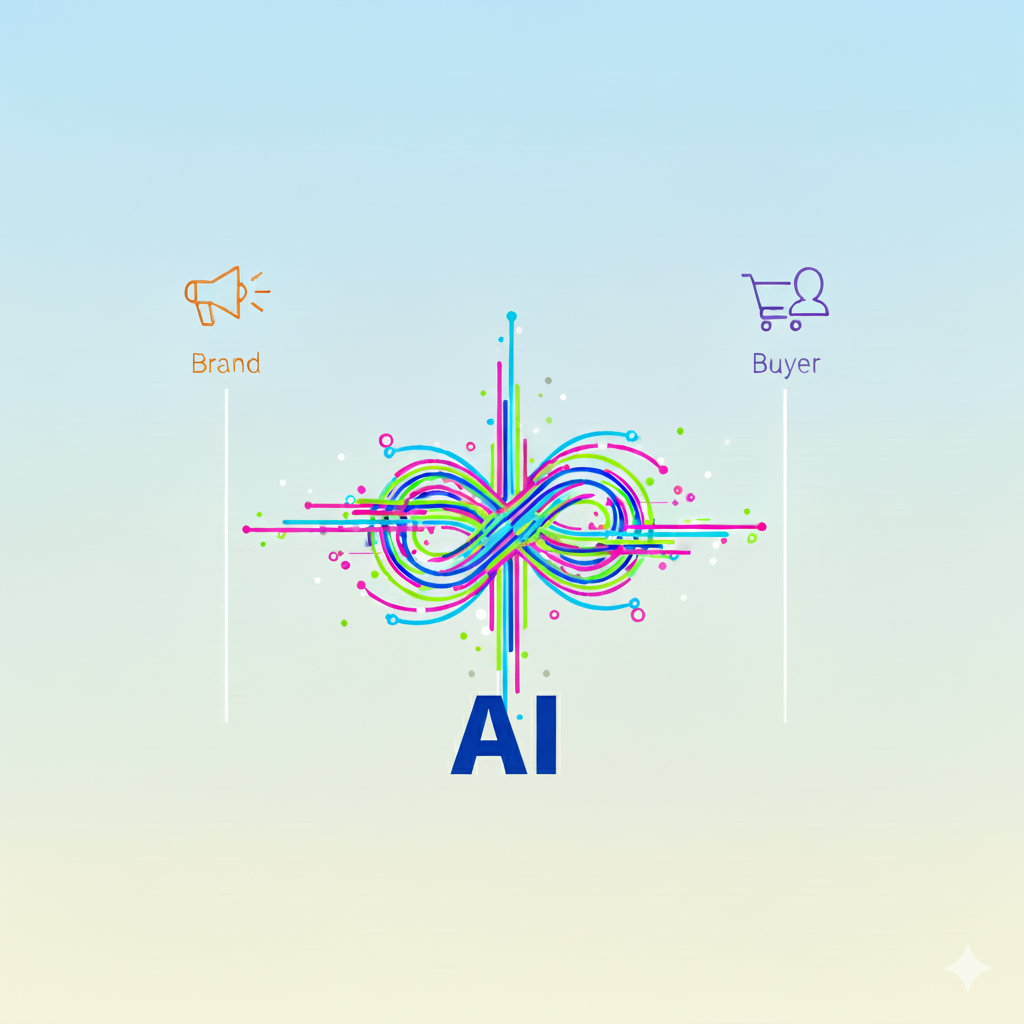Curation Effect: How AI Quietly Took Control of the Brand-to-Buyer Conversation

Your SEO strategy is failing, and it’s not your fault
For years, the marketing playbook was simple: earn visibility, buy reach, and measure clicks. We built our engines on the idea that discovery leads to engagement, and engagement leads to conversion. But AI is collapsing that sequence in real time. Discovery and decision are starting to happen in the same breath, inside a synthetic conversation your brand doesn’t control.
That’s the new reality forming around The Curation Effect, a shift where artificial intelligence no longer just assists but mediates. It’s filtering, ranking, and rewriting how audiences see, choose, and buy. And it’s doing so faster every month.
AI was never just a backstage tool. It has always been moving toward control, first over the content we create, now over the conversations we have. What’s changing is not its capability, but its position. It is stepping squarely between brands and buyers, becoming the active mediator that filters, ranks, and rewrites what audiences see and do. It’s no longer assisting marketers; it’s now beginning to obstruct and diminish them.
Remember the game, and the new rules
Remember the game Monkey in the Middle we played as kids. Two people toss a ball while someone in the center leaps and swipes, desperate to grab it. No one wanted to be the monkey. It was the losing spot, stuck between the action, never really part of the game. And how often did you see the kid in the middle smiling, while the ones on the outside were grinning ear to ear?
Except now, the monkey does want to be in the middle. In fact, it’s fighting to stay there. And its name is AI. But what’s different now is it’s not a game anymore. Or even a fair one at that.
The Curation Effect: when access gets intercepted
At SH/FT, we call this The Curation Effect, the moment AI stopped being a productivity enhancer and started becoming the interface. Once, brands controlled their channels. Today, AI is beginning to control access. And the handoff isn’t over yet.
Search is where it all started
Search is where the shift first became visible.
Not every query triggers an AI or LLM driven result yet, but the trend is unmistakable. The biggest shifts are happening in non-branded informational searches, the questions that used to power the top of every marketing funnel. Ask “how to lower blood pressure” and you’ll see it: the Mayo Clinic, long the authority, is pushed below the fold. Search “average mortgage rate right now” and you’ll find only two standard results above the fold where there used to be five or six. Try “best credit cards for travel” and you’ll see the real story. Google’s AI Overview doesn’t just summarize, it sorts and ranks based on whatever it decides matters in that moment. It’s not personal in the human sense; it’s algorithmic intuition. Brands have no control over what factors it favors or how it weighs them.
Below the fold, below the line
That is curation in motion. Somewhere in that answer are plenty of products that used to appear organically and now simply don’t. And even if they did, most people would never see them. The new LLM experience occupies nearly all of the above-the-fold real estate on most searches, pushing traditional results far down the page. The handful of links that remain visible get disproportionate attention, while everything below the scroll line may as well not exist. No one goes to page two or three anymore. In a few cases, these AI summaries may even help a select few by locking in that first-page prominence, but they’re erasing visibility for everyone else.
Visibility is not equal to traffic
And this is where the rules start to diverge. Visibility and traffic no longer move in tandem, and that gap is widening fast.
You can’t brute force your way to organic traffic anymore, at least not with the efficiency or predictability of the past. The visibility game has changed. The model is the interface now, and it decides who gets seen, who gets cited, and who gets left behind.
The death of distribution
For publishers, this is an existential turning point. The open web used to reward distribution: publish more, earn links, and grow reach. Now, that reward system is collapsing into containment. The more successful your content is, the more likely it is to be summarized by an AI that never sends readers back. Visibility still exists, but it’s detached from traffic. Content now fuels awareness inside the model, not necessarily visitors to your page.
The same is true for retailers, educators, and service providers. Product listings, course content, and even brand messaging are being scraped, summarized, and re-presented directly inside AI-driven experiences. Traffic that once flowed through owned channels is now rerouted through AI intermediaries that capture the attention and the transaction.
The new leverage equation
That doesn’t mean creation is dead; it means the value chain has shifted. The future is about leverage, not volume. Those who adapt will move from chasing clicks to owning connections. They’ll build data, communities, and experiences that AI can’t fully replicate or contain.
You either play the machine’s game by making your content readable, referenceable, and reusable, or you build your own lane around it, owning your audience outright through proprietary platforms, membership ecosystems, and direct experiences.
Playing in two worlds
AI isn’t just a tool; it’s becoming an interference layer. It’s reshaping how audiences consume, how algorithms rank, and how every dollar of marketing spend performs. The Curation Effect means that brand, performance, and product strategies now have to evolve together because the machine doesn’t distinguish between them.
The transition won’t be comfortable. But the brands that thrive will be the ones that can operate in both worlds, the legacy systems still driving short-term revenue and the AI ecosystems defining long-term reach. They’ll understand that the game isn’t about owning attention anymore; it’s about owning the relationship. They’ll speak in ways AI understands without losing their voice. They’ll invest in the data, trust, and experience that carry their message directly to the customer, no mediator required.
Adapt while the game is changing
Because in this new game, the monkey isn’t going away. It’s learning faster than we are. It’s expanding from search to inbox to storefront to every digital moment that moves a dollar.
So the real question isn’t how to beat it. It’s how to adapt while the game is still being rewritten.
AI may be the monkey in the middle, but the brands that learn to ‘throw it the ball,’ in other words feeding it the right signals, data, and structure, are the ones that learn to play a different game entirely will be the ones that win.
If you’d like to continue this conversation, follow SH/FT and me (Isaac) on LinkedIn.
If you have a growth or AI challenge today, reach out to us at shiftparadigm.com/contact.
P.S. Hopefully my links weren’t removed by AI-based search, but if they were, just search “Shift Paradigm” or “Isaac Ferreira” on LinkedIn.





